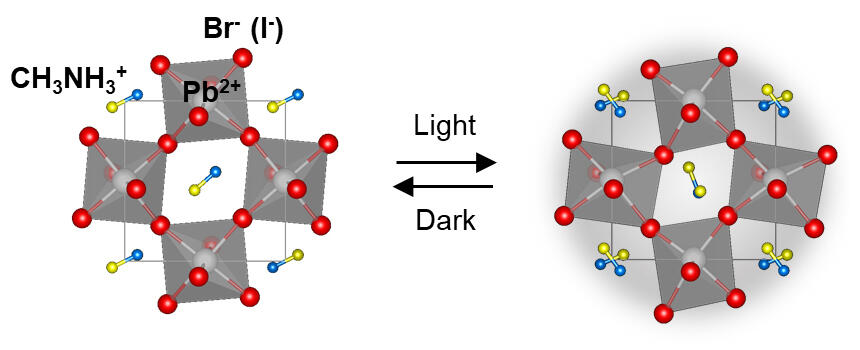The research team, led by Associate Professor Takashi Tachikawa of the Molecular Photoscience Research Center, Kobe University and Principal Researcher Satoshi Tominaka of the National Institute for Materials Science and International Center for Materials Nanoarchitectonics, in collaboration with Team Leader Takahito Nakajima of the RIKEN Center for Computational Science, Special Researcher Takahide Matsuoka, Principal Researcher Koji Ohara of the Japan Synchrotron Radiation Research Institute, and others, observed that in perovskites containing multiple halide ions, the change in emission characteristics due to light irradiation is caused by a slight change in the crystal structure at the sub-ångström level. They also found that this structural change can be suppressed by inactivating the lattice defect injection on the crystal surface.
Halogen-mixed organic-inorganic perovskite containing Br and I ions has attracted attention as a highly efficient solar cell material and light-emitting material, but there is a drawback that phase separation occurs via light irradiation resulting in the performance of the device deteriorating. In this study, it was clarified that the emission wavelength changes considerably through local distortion of the crystal structure by simply irradiating the nanocrystal (CH3NH3PbBr1.5I1.5) with light. When the appearance of each nanocrystal emitting light was observed using a fluorescence microscope, a new emission peak appeared on the long wavelength side due to light irradiation. This spectral change has been considered to be a behavior suggestive of photoinduced phase separation.
To investigate what type of structural change occurs inside the perovskite crystal, total X-ray scattering measurement using high-intensity synchrotron radiation was performed on the Super Photon ring-8 GeV SPring-8. As a result, it was clarified that the positions of the halide ions (Br and I ions) did not change considerably even under light irradiation, and the change in the emission characteristics was not due to phase separation. A detailed analysis revealed that the octahedral unit comprising Pb2+ ions and halide ions was slightly distorted by light irradiation, and the symmetry of the crystal structure was changed. From the first-principles electronic state calculation, it was suggested that the change in the atomic arrangement accompanied by the breaking of the symmetry affects the electronic state of the perovskite and causes the emission wavelength to be lengthened.

(Provided by Kobe University)
Associate Professor Tachikawa commented on the findings, "It was shown that it is possible to improve the stability of perovskite solar cells by suppressing the structural changes observed this time. By applying this feature, a new optoelectronic device could be developed that can control light emission characteristics and ferroelectricity at high speed by light stimulation."
This article has been translated by JST with permission from The Science News Ltd.(https://sci-news.co.jp/). Unauthorized reproduction of the article and photographs is prohibited.




